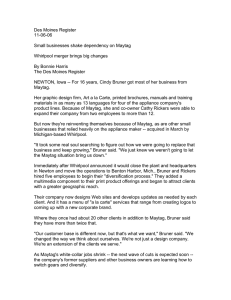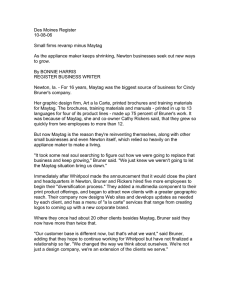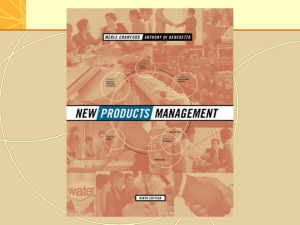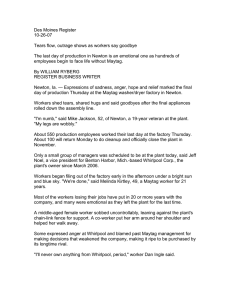Des Moines Register 07-16-06 Elbert: Business prof at ISU predicted Maytag troubles
advertisement
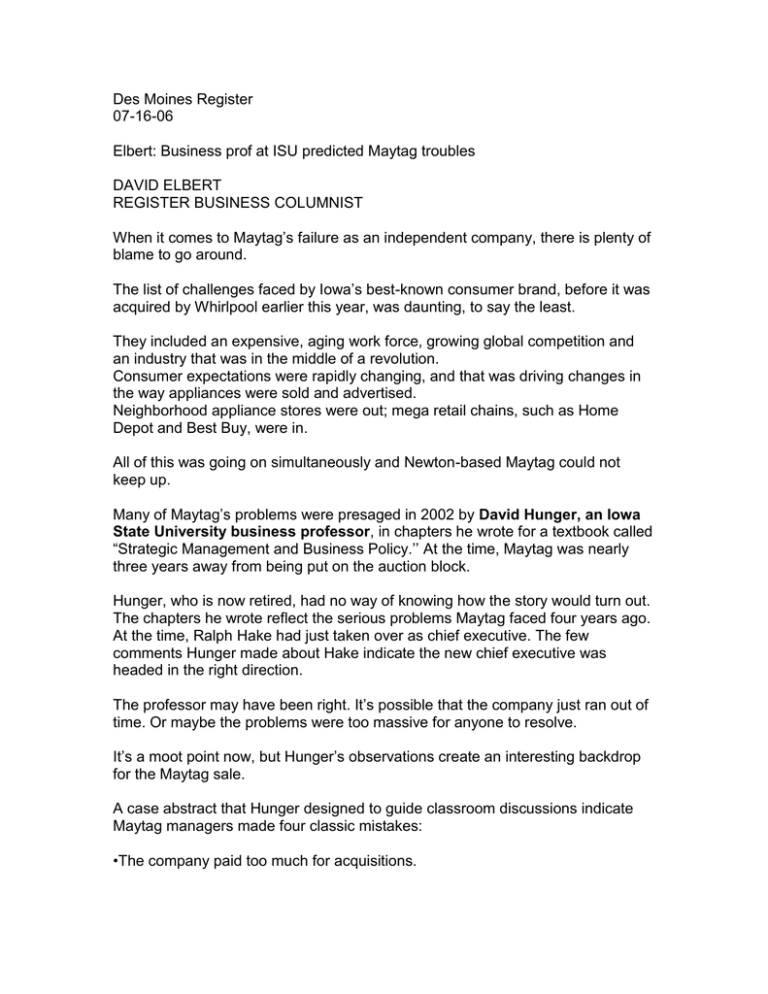
Des Moines Register 07-16-06 Elbert: Business prof at ISU predicted Maytag troubles DAVID ELBERT REGISTER BUSINESS COLUMNIST When it comes to Maytag’s failure as an independent company, there is plenty of blame to go around. The list of challenges faced by Iowa’s best-known consumer brand, before it was acquired by Whirlpool earlier this year, was daunting, to say the least. They included an expensive, aging work force, growing global competition and an industry that was in the middle of a revolution. Consumer expectations were rapidly changing, and that was driving changes in the way appliances were sold and advertised. Neighborhood appliance stores were out; mega retail chains, such as Home Depot and Best Buy, were in. All of this was going on simultaneously and Newton-based Maytag could not keep up. Many of Maytag’s problems were presaged in 2002 by David Hunger, an Iowa State University business professor, in chapters he wrote for a textbook called “Strategic Management and Business Policy.’’ At the time, Maytag was nearly three years away from being put on the auction block. Hunger, who is now retired, had no way of knowing how the story would turn out. The chapters he wrote reflect the serious problems Maytag faced four years ago. At the time, Ralph Hake had just taken over as chief executive. The few comments Hunger made about Hake indicate the new chief executive was headed in the right direction. The professor may have been right. It’s possible that the company just ran out of time. Or maybe the problems were too massive for anyone to resolve. It’s a moot point now, but Hunger’s observations create an interesting backdrop for the Maytag sale. A case abstract that Hunger designed to guide classroom discussions indicate Maytag managers made four classic mistakes: •The company paid too much for acquisitions. “A list of Maytag’s acquisitions since 1995 shows only losers for which Maytag paid high and sold low,” Hunger wrote. Exhibit A was G.S. Blogett Corp., a manufacturer of commercial ovens, which Maytag paid $148million for in 1997 and sold for $95million in 2001. Other acquisitions resulted in higher than expected costs after the fact. Maytag managers “failed to identify how much time and money it would take to make Hoover’s overseas operations competitive” and eventually sold those operations at a loss, too, Hunger wrote. The string of acquisitions that began in the 1980s and ended with the purchase of Amana in 2001 created a crushing debt load for Maytag and ultimately made it vulnerable to takeover. •Maytag acquired businesses it didn’t understand. Blogett and Hoover were both appliance makers, but the commercial ovens that Blogett made and the floor-care products that Hoover made had significantly different marketing and distribution systems from the washer-dryer-refigerator appliances made by Maytag. Vending machine maker Dixie-Narco was another acquisition that was far afield from Maytag’s core of major household appliances. •Top Maytag executives did a poor job managing corporate culture. Maytag’s culture went all the way back to the founder, F.L. Maytag. It emphasized “high quality, dependable performance, and promotion from within,” Hunger wrote. “The promote-from-within value probably contributed to the company’s difficulty with executive succession,” Hunger wrote. Lloyd Ward’s one-year term as chief executive “was a disaster,” he notes, in part because Ward tried to make “changes that went directly against the corporate culture,” including moving the headquarters out of Newton. Like many companies, Hunger said, Maytag “tended to force its culture on its acquired units.” The strategy worked with most U.S. acquisitions, but given the company’s strong culture, “it is easy to see why Maytag had such difficulty with Hoover Europe (which had a laid-back culture) and its Chinese joint venture,” which Maytag executives abandoned in 2001. •Maytag did a poor job of integrating acquisitions. Going all the way back to the late 1970s when Dan Krumm was chief executive, Maytag leaders recognized that the company needed to grow to survive, and the company went on a buying spree in the 1980s. Business schools teach that it is all right to pay a premium for acquisitions, if there is a workable strategy for bringing down the cost of doing business. It turned out that Maytag either did not have such a strategy, or it did not have one that worked. As recently as 2004, Maytag was trying to find synergies between its core operations and Hoover’s floor-care business, which was acquired at a premium in 1988. “Industry analysts concluded that the Hoover acquisition had been a strategic error,” Hunger wrote. As shareholders and others learned during the year leading up to the Maytag sale, the Hoover acquisition was far from the only mistake.
